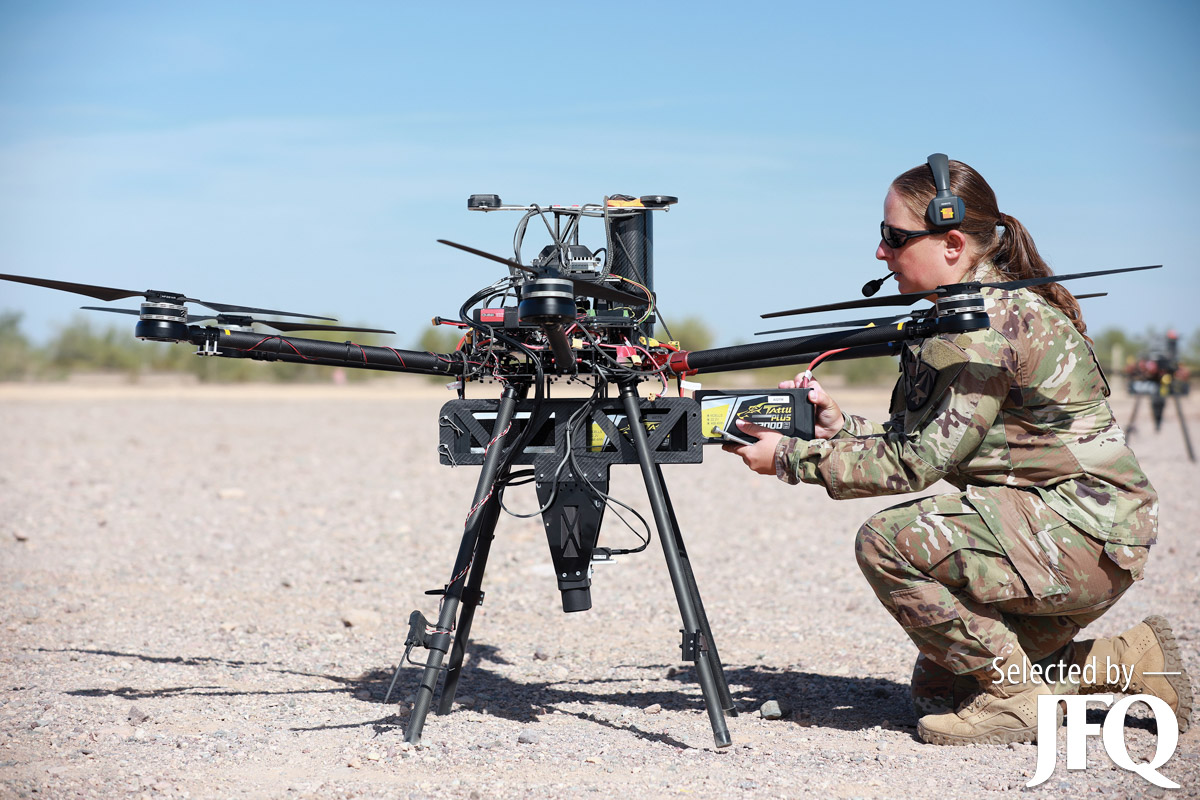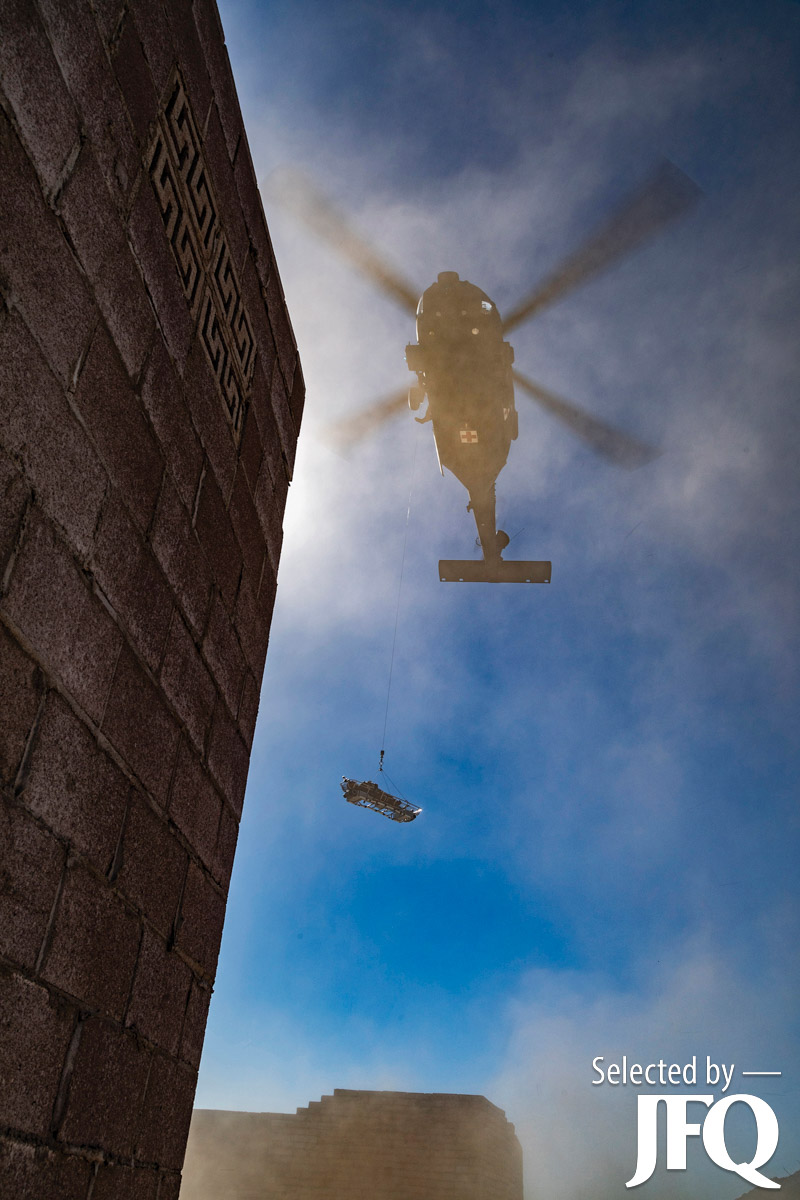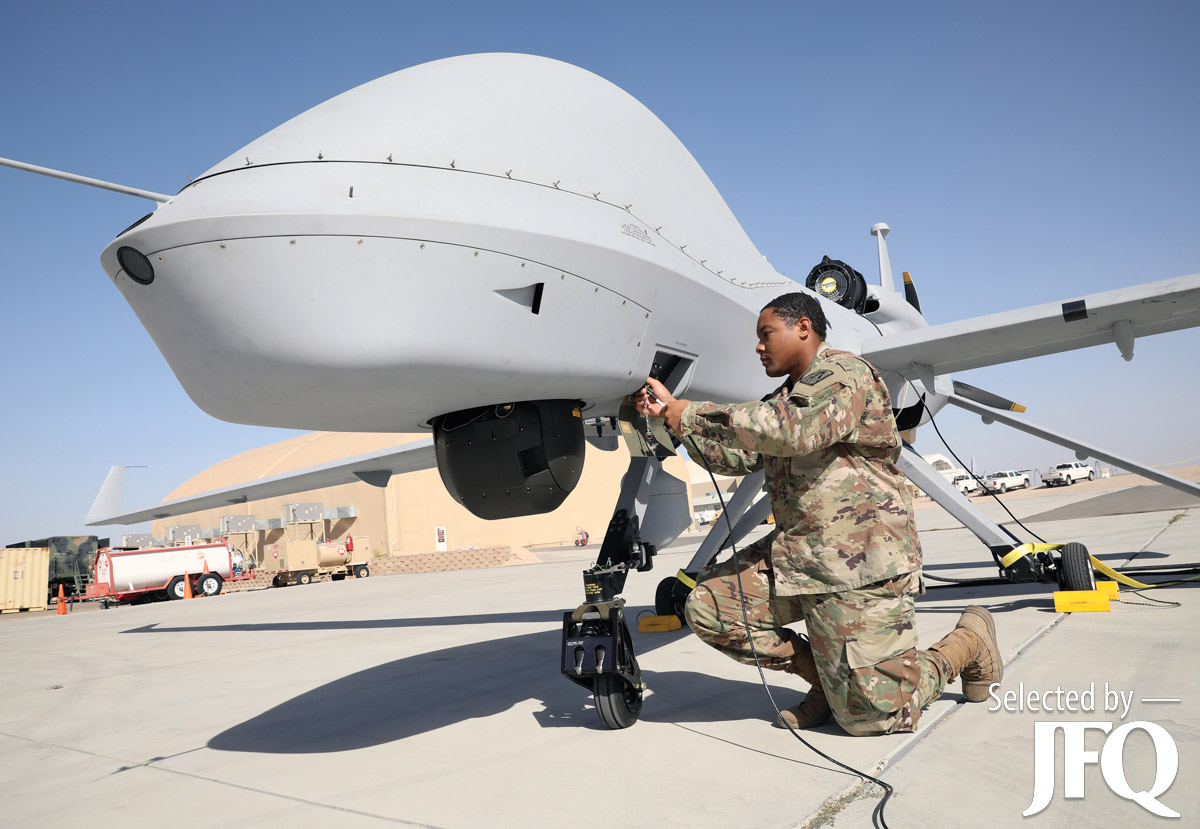Download PDF
Lieutenant General James M. Richardson, USA, is Deputy Commanding General of United States Army Futures Command.
 Army Staff Sergeant Elise Denning, assigned to Artificial Intelligence Integration Center, conducts maintenance on unmanned aerial system in preparation for Project Convergence 21 at Yuma Proving Ground, Arizona, October 20, 2021 (U.S. Army/Destiny Jones)
Army Staff Sergeant Elise Denning, assigned to Artificial Intelligence Integration Center, conducts maintenance on unmanned aerial system in preparation for Project Convergence 21 at Yuma Proving Ground, Arizona, October 20, 2021 (U.S. Army/Destiny Jones)
You are doing a lot of experiments. Show me where it matters. Show me where connecting people and moving information-processing matters to an operational result.
—Frank Kendall III, Secretary of the Air Force1
What does the joint force need to do right now to succeed during future conflicts in 2030, 2040, or beyond? The answer is clear: we must experiment together. We must assess the characteristics of the future operating environment (in terms of the physical environment, the threat, and the state of technology). We must develop, test, and refine concepts for how we will operate in that environment. We must also develop and deliver joint capabilities that give our Servicemembers advantage over any adversary in that environment. None of this happens without experimentation. Together, we must learn, fail, learn again, and fail again so that we eventually succeed.
We will fight as a joint team, so we must experiment as a joint team. We must experiment with and assess our ability to enable joint force commanders to execute Joint All-Domain Command and Control (JADC2). JADC2 is both the concept and the “capabilities needed to command the joint force across all warfighting domains and throughout the electromagnetic spectrum to deter and, if necessary, defeat any adversary at any time and in any place around the globe.”2 This analysis must lead to action in terms of writing requirements and resourcing technology.
Some may not believe that it is possible for the Services to willingly collaborate in experimentation. I am more optimistic and cite Project Convergence (PC) as an example. For the past 2 years, the Army, Marine Corps, Navy, Air Force, Space Force, and U.S. Special Operations Command have worked together and collaborated in the name of integrated experimentation through PC. In this article, I describe how Project Convergence emerged as a venue for joint experimentation to inform the evolution of JADC2 from the tactical to operational levels of war.
First executed in the summer of 2020, Project Convergence originated as an annual capstone experiment to solve Army problems but not necessarily joint ones. The road to PC, though, began several years earlier when the Army established its core six modernization priorities and stood up eight cross-functional teams (CFTs), each led by a general officer or Senior Executive Service charged with supporting the delivery of these modernization priorities.3
In November 2018, then Secretary of the Army Mark T. Esper and Chief of Staff of the Army General Mark Milley published the Army Strategy (TAS), which established modernization as one of the Service’s four lines of effort. The others were to build readiness, reform, and strengthen alliances and partnerships.4 That same year, the Service established Army Futures Command (AFC) as its first new four-star headquarters since 1973. Its mission is to synchronize and integrate modernization across the Future Force Modernization Enterprise.5 In addition to the CFTs, AFC received command authority over existing organizations, such as the Futures and Concepts Center, Joint Modernization Command, Research and Analysis Center, Combat Capabilities Development Command, and Medical Research and Development Command.
The Army’s laboratories and battle laboratories now fell under AFC. Each conducted significant amounts of materiel or conceptual experimentation. The question was where did this experimentation lead and how did it get integrated into the Army’s modernization priorities. The answer was disappointing; efforts did not necessarily lead anywhere and were not always nested with Army priorities. AFC, a single headquarters with unity of command over these laboratories and the ability to create unity of effort across the Army Modernization Enterprise, was now postured to solve this problem.
Project Convergence, which began as an idea on a white board back in early 2020, became the aim point for all the other experimentation. We sought to link Army sensors, command and control (C2) nodes, and shooters at the tactical level to enable faster decisionmaking under the premise of “whoever can see, understand, decide, and act first will win.”6 It pulled Soldiers, scientists, and industry together in the dirt for a month at Yuma, Arizona, to experiment with promising technologies under the pressure of tactical scenarios.
I am the first to admit that our experimentation during Project Convergence 2020 was rudimentary and ground-centric. We developed realistic tactical scenarios and integrated technologies such as robotic combat vehicles (air and ground), autonomy stacks, data fabrics, weapon-target-pairing technologies, and long-range precision munitions. Although we learned a great deal during PC20, our biggest takeaway was the need to include joint partners. We realized clearly that linking Army sensors, C2 nodes, and shooters was not sufficient; the experiment did not even reflect how we fight now, let alone how we might fight in the future. No single Service will ever fight alone. We fight as a joint team. Moving forward, we needed to change PC.
As soon as PC20 ended, AFC began planning PC21, and we reached out to all our joint partners and invited them to participate and use PC21 to further their own experimentation objectives. Our premise was that the Army would provide the “sandbox,” and everyone was welcome to come play if they agreed to integrate their technologies across Services. They all accepted. PC21 and successive iterations would allow the joint force to discover, in the words of Chief of Staff of the Army General James C. McConville, “the speed, range and convergence of cutting-edge technologies that will be needed to provide future decision dominance and overmatch for great power competition.”7
 Flight Systems Branch personnel from Army Aeromedical Research Laboratory demonstrate Load Stability System–Litter Attachment during hoist operations with 82nd Airborne’s Integrated Visual Augmentation System–enabled air assault teams as part of Project Convergence 21 at Yuma Proving Ground, Arizona, October 26, 2021 (U.S. Army/Scott C. Childress)
Flight Systems Branch personnel from Army Aeromedical Research Laboratory demonstrate Load Stability System–Litter Attachment during hoist operations with 82nd Airborne’s Integrated Visual Augmentation System–enabled air assault teams as part of Project Convergence 21 at Yuma Proving Ground, Arizona, October 26, 2021 (U.S. Army/Scott C. Childress)
As a mechanism to ensure that Service experimentation needs were being met, every month leading up to PC21 we convened a Joint Board of Directors (JBOD) that included three-star representation from each of the partners. Although the Army provided much of the overhead for PC21, each partner funded its own technologies and participation. PC21 experimentation focused on seven joint use cases agreed to by the JBOD. A use case is nothing more than a tactical scenario or problem. Joint Air and Missile Defense is an example. Each use case included combinations of sensors, C2 nodes, and shooters from across all Services. We knew that our biggest challenges were moving data and getting authority to operate, translators, and cross-domain-solutions for the 180-plus technologies to operate and share data on the Department of Defense network. Months prior to the experiment, the Services nominated the technologies they would bring into each use case, and AFC’s operational and systems architects began mapping those technologies together. We conducted multiple lab-based risk reduction events at the Joint Systems Integration Laboratory at Aberdeen Proving Grounds, Maryland, to validate our network design and ensure accurate end-to-end data flow.
Because of the joint governance we established, and tremendous hard work by Servicemembers, civilians, and industry partners in the labs and on the ground at Yuma and White Sands Missile Range, New Mexico, PC21 was a resounding success.
However, success is not only what we were able to accomplish on the ground in Yuma but also what we were not able to accomplish—and how that drove change. One of our biggest takeaways from PC21 was that we have not gotten it right with data. We tout that “data is the new ammunition,” but as a joint force we remain unable to enter the battlespace and seamlessly exchange data to enable JADC2. We still leverage point-to-point data standards, some decades old. PC21 gave us the venue to identify multiple data standards that were insufficient for tomorrow’s fight and take those recommendation directly to the JADC2 CFTs for action, proving the value of a bottom-up approach to JADC2. Additionally, within the Army, the overhaul of the Service’s requirements process, to ensure system integration and data centricity are addressed prior to prototyping, has begun.
Other major lessons learned from PC21 have driven both the creation of new requirements documents and the adjustments to requirements documents already approved. PC21 identified the need to develop and enforce a common data standard, message format, and a single data fabric capability to achieve integration across the Services and amplify machine-to-machine speed. This finding has greatly informed the development of a requirements document to support a common data fabric (Project Rainmaker8). PC21 further refined the need for a joint integrated fire control network—Army Integrated Air and Missile Defense being the Service’s contribution to this fires network. PC21 also highlighted promising technologies ripe for transition from science and technology into the development of the Technology Maturation Initiative—automation of the target-weapons pairing process (FIRESTORM9) and tools that support increased decision speed for long-range effects (SHOT10). PC21 allowed Services to influence development of a joint common operating picture and improve joint all-domain situational awareness solutions.
Specifically, the Services were able to explore, test, and score the two-way transmission and interoperability of the Command Post Computing Environment as a potential replacement for the Global Command and Control System–Joint. This opportunity taught us that there is more work to be accomplished; none of the five potential data fabrics tested displayed the required maturity, and cross-domain solutions to bridge information-sharing between Services improved interoperability but became single points of failure. Finally, PC21 reiterated the importance of the tactical network to everything the joint force does. PC21 has proved that the tactical network is the center of gravity in our operations and that we need to continue to evolve our network at the speed of relevance.
Project Convergence is also identifying capability shortfalls that support the need for Soldiers with emerging technical skill sets to support achieving the intent of JADC2. This includes Soldiers with increased data science and agile software development proficiency to enable future combat operations. To meet this need, the Artificial Intelligence Integration Center (AI2C) and the Army Software Factory (ASWF) are identifying and recruiting Soldiers with technical talent from across the Service and teaching them to employ agile tools and data science to modernize mission operations and solve real problems. AFC will continue to guide and support organizations such as AI2C and ASWF to teach Soldiers with critical skill sets to prototype a future force design.
Frank Kendall III, Secretary of the Air Force, is right: we must experiment to connect people, process information, and create an operational impact. Project Convergence consistently reminds us that we must take a system-of-system approach and move away from strap-on solutions such as translators to achieve interoperability across Services. Instead, we must write our requirements aimed at achieving full integration of systems with the joint force and our allies.
Christine Wormuth, Secretary of the Army, and General McConville testified in May 2022 before the Senate Armed Services Committee that PC21 included nearly 1,500 participants from the Army, Marine Corps, Navy, Air Force, and Space Force, making it the largest joint force experiment in 15 years.11 PC is a key tenet of the experiment. The experiment gives the joint force opportunities to use any sensor, the best shooter, and the right C2 node to fuse data and accelerate sensor-to-shooter times. During PC we integrated the F-35B with ground shooters to complete the kill web. In other cases, we have increased the speed of sensor to shooter from minutes to seconds. Time and again, Project Convergence is providing a venue for Services to experiment with new technologies to solve significant operational challenges.
 Army Private First Class Terry Hollywood, assigned to 224 Military Intelligence Battalion, conducts maintenance on MQ-1C Gray Eagle in preparation for Project Convergence 21 at Yuma Proving Ground, Arizona, November 11, 2021 (U.S. Army/Marita Schwab)
Army Private First Class Terry Hollywood, assigned to 224 Military Intelligence Battalion, conducts maintenance on MQ-1C Gray Eagle in preparation for Project Convergence 21 at Yuma Proving Ground, Arizona, November 11, 2021 (U.S. Army/Marita Schwab)
Despite the many successes and lessons learned associated with the Project Convergence campaign of learning, many criticisms and misunderstandings exist from across the joint force. Some question why the Army is leading a joint experiment. Others ask what the other Services are doing. Still others want to know if PC is simply a series of science experiments put together to see if they might work. Each Service realizes that experimentation is necessary to integrate our future platforms, and each conducts its own flagship experiment to contribute to JADC2—a domain and control system that connects existing sensors and shooters to data that is available in all domains. All are necessary, but PC offers a subtle and valuable difference by leveraging jointness in governance and execution across all domains.
As this article is published, we will be on the precipice of executing the third iteration of Project Convergence—PC22. PC22 will be a combined joint force experiment aimed at developing capabilities that can defeat adversaries in large-scale combat operations, building on the successes achieved last year by increasing the scale and complexity of the use cases. Additionally, PC22 welcomes some of our closest allies and partners as participants and observers. In January 2022, our JBOD expanded to become a Combined JBOD with partners from Australia, Canada, and the United Kingdom participating in addition to the Services.
PC22 centers on two scenarios. The first is an Indo-Pacific scenario experiment replicated on the West Coast of the United States at locations across the joint force. The second experiment is a European scenario that takes place in the southwest U.S. desert. In both scenarios, we insert and integrate hundreds of promising technologies and assess the scalability and capacity of the capability that those technologies provide and focus on where they fail.
We owe it to the Nation and to all Servicemembers who will be in harm’s way in the future to conduct joint, integrated experimentation. Project Convergence has emerged as a venue to inform the evolution of JADC2. It is enabling us to achieve decision dominance by testing the speed, range, and convergence of cutting-edge technologies. Moreover, PC offers a framework to conduct experimentation across the joint force and with our allies and partners. We do not know when we will fight the next war, but the experimentation provided by Project Convergence ensures that we have the right military organizations with the right capabilities to achieve overmatch for Great Power competition. JFQ
Notes
1 Air & Space Forces Association, “Air and Space Leaders in Action with Air Force Secretary Frank Kendall,” video, 1:01:27, June 27, 2022, available at <
>.
2 Summary of the Joint All-Domain Command & Control (JADC2) Strategy (Washington, DC: Department of Defense, March 2022), available at <https://media.defense.gov/2022/Mar/17/2002958406/-1/-1/1/SUMMARY-OF-THE-JOINT-ALL-DOMAIN-COMMAND-AND-CONTROL-STRATEGY.PDF>.
3 Ryan D. McCarthy and Mark A. Milley, “Modernization Priorities for the United States Army,” October 3, 2017, available at <https://vtol.org/files/dmfile/10062017_Army_Modernization1.pdf>. This document established six Army modernization priorities: long-range precision fires, next-generation combat vehicle, future vertical lift platforms, Army network, air and missile defense capabilities, and Soldier lethality. Also see Army Directive 2017-24, Cross-Functional Team Pilot in Support of Materiel Development (Washington, DC: Headquarters Department of the Army, October 6, 2017), available at <https://armypubs.army.mil/epubs/DR_pubs/DR_a/pdf/web/ARN6101_AD2017-24_Web_Final.pdf>. This directive established eight cross-functional teams: long-range precisions fires; next-generation combat vehicle; future vertical lift; network command, control, communication, and intelligence; assured positioning, navigation, and timing; air and missile defense; Soldier lethality; and synthetic training environment.
4 The Army Strategy (Washington, DC: Headquarters Department of the Army, October 25, 2018), available at <https://www.army.mil/e2/downloads/rv7/the_army_strategy_2018.pdf>.
5 General Orders No. 2018-10, Establishment of United States Army Futures Command (Washington, DC: Headquarters Department of the Army, June 4, 2018), available at <ARN11199_GO1810_FINAL.pdf>.
6 U.S. Army, “Project Convergence: A Campaign of Learning,” video, 3:39, September 24, 2020, available at <
>.
7 “Army Releases Information Paper on Multi-Domain Transformation,” U.S. Army Public Affairs, March 23, 2021, available at <https://www.army.mil/article/244543/army_releases_information_paper_on_multi_domain_transformation>.
8 Sydney J. Freedberg, Jr., “Project Rainmaker: Army Weaves ‘Data Fabric’ to Link Joint Networks,” Breaking Defense, November 17, 2020, available at <https://breakingdefense.com/2020/11/project-rainmaker-army-weaves-data-fabric-to-link-joint-networks/>.
9 Kris Osborn, “Firestorm: We Watched the U.S. Army’s New AI System Fight a Simulated War,” The National Interest, September 26, 2020, available at <https://nationalinterest.org/blog/buzz/firestorm-we-watched-us-armys-new-ai-system-fight-simulated-war-169669>.
10 Ray Alderman, “How Rainmaker, Prometheus, FIRESTORM, and SHOT AI Algorithms Enable the Kill Web,” Military Embedded, December 23, 2021, available at <https://militaryembedded.com/radar-ew/sensors/how-rainmaker-prometheus-firestorm-and-shot-ai-algorithms-enable-the-kill-web>.
11 Statement by The Honorable Christine E. Wormuth, Secretary of the Army, and General James C. McConville, Chief of Staff United States Army, Before the Committee on Armed Services, On the Posture of the United States Army, U.S. Senate, 117th Cong., 2nd sess., May 5, 2022, available at <https://www.army.mil/e2/downloads/rv7/aps/aps_2022.pdf>.